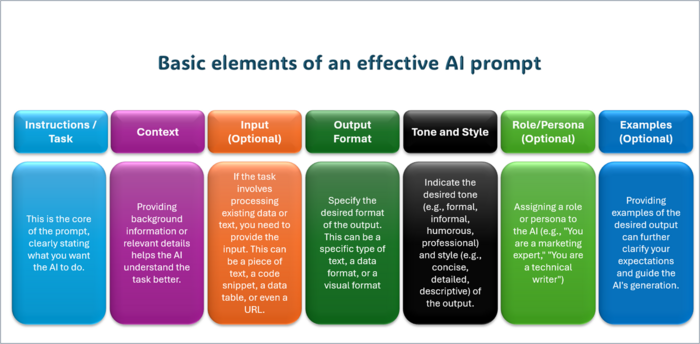Today, AI is no longer just a concept found in science fiction books or Hollywood movies. Even ordinary people can now access AI tools like Google Gemini, Google Assistant, Amazon Alexa, or Meta AI through their mobile phones or smart devices. Tech professionals are leveraging the power of AI tools to do research and development, boost productivity and efficiency, automate repetitive tasks, and enhance their skills.
AI is marking new standards for technical writers and information developers by providing infinite ways to revolutionize and improve documentation tasks. Utilization of AI tools can significantly reduce the amount of time and effort we invest in crafting user-centric documentation. We can consider AI tools as powerful collaborators that can help technical writers gather information, break down complex content, improve the structure of documents, assist in problem-solving, and much more. By leveraging the power of AI, technical writers can improve the effectiveness of the documents they create.
The key benefits of utilizing AI in technical writing include:
Documentation planning
- Information gathering
- Research and analysis
- Requirements analysis
- Idea generation
- Brainstorming
Content generation
- Initial draft preparation
- Provide content ideas and arrangement
- Outline the structure
- Content curation
- Create descriptions and titles
Content improvement
- Check plagiarism
- Create accessible content
- Tailored content for target audiences
- Check for errors and inconsistencies
- Grammar and spelling check
- Translate content
- Content optimization
Miscellaneous
- Fact-checking
- Feedback analysis
- Legal and compliance check
- Data analysis and visualization
Crafting effective AI prompts
According to Google, “a prompt is a natural language request submitted to a language model to receive a response back. Prompts can contain questions, instructions, contextual information, few-shot examples, and partial input for the model to complete or continue.”
To get relevant context and accurate content, the user needs to make a well-crafted prompt that the language model can understand and generate the desired response. The process of crafting well-structured prompts is called “prompt design” or “prompt engineering”.
Creating a well-crafted prompt is not that difficult. Language models are engineered to understand even casual language patterns. You can enhance your prompts using the trial-and-error method by incorporating additional information such as the task and context details, role guidelines, output format, and much more.
General documentation tasks
When we write content for technical documents, we usually review it to improve its quality and clarity. Manual rewriting, simplifying, summarizing, or enhancing the readability of content is time-consuming and requires careful reading and verification. Utilizing the power of AI text-processing tools can lighten the load and transform the content while maintaining accuracy, consistent tone, style, and level of detail. The following AI prompts can assist you with daily documentation tasks, including rephrasing, rewriting, simplifying, and summarizing content:
- Rewrite: “Rewrite this sentence to be more concise.”
- Simplify: “Explain this technical concept in simpler terms.”
- Catchy heading: “Generate a catchy heading for this article.”
- Table of contents: “Create a table of contents for this document.”
- Call to action: “Write a strong call to action for this document.”
- Summarize: “Summarize the key points of this article.”
Editing and proofreading
Proofreading and editing are the keys to producing high-quality documentation. When technical writers and editors review lengthy documents, they might produce human errors such as missed typos, punctuation, and grammatical errors, especially when they are fatigued. AI tools can identify spelling mistakes, grammatical errors, and punctuation issues effectively. Following AI prompts can be utilized to proofread and edit content, reducing the risk of human error:
- Review: “Proofread this content for grammar, punctuation, and spelling errors.”
- Improve: “Improve the clarity and coherence of the given content."
- Redundancy: “Identify any redundant or unnecessary phrases in this content.”
- Consistency: “Check the consistency of terminology and style in the following content."
- Readability: “Improve the readability of the content by breaking long paragraphs.”
Improving content
Elaborating and rewriting complex information and technical concepts can be challenging. This requires subject-matter expertise and specialized knowledge. AI tools can save the technical writer’s time and effort in improving existing content by providing examples, additional information, and references. Use the following AI prompts to improve existing content and document structure:
- Elaborate: “Elaborate on this topic with more details and examples.”
- Rewrite: “Rewrite this sentence to make it more concise and impactful.”
- Inconsistency: “Identify any logical inconsistencies or contradictions in this content.”
- Structure: “Suggest ways to improve this document’s overall structure and organization.”
Style and tone
AI text-processing tools can be utilized for tone analysis of documents. They can check the dominant tone across the document, such as formal/informal or positive/negative. Based on the analysis, they can provide suggestions for improvement or rewrite the content as per the requirement. Use the below AI prompts to identify potential issues with voice, tone, writing style, persuasiveness, etc.:
- Tone: “Make the tone of this text more formal/informal.”
- Persuasiveness: “Enhance the persuasiveness of this argument.”
- Writing style: “Ensure the writing style is consistent with the target audience.”
- Change voice: “Convert passive voice sentences to active voice.”
- Vivid language: “Add more vivid language and imagery to this text.”
Research
Compared to normal search engines, AI-powered search engines and Natural Language Processing tools can extract key information from unstructured text by understanding the context and meaning of the query. They search for relevant information in vast datasets, which contain articles, research papers, web pages, reports, etc. Data mining and visualization tools provide valuable insights and a better understanding of complex information through data visualization.
- Features and benefits: "What are the key features and benefits of [product/technology]?"
- Pain points: "What are the common pain points or challenges users face with [product/technology]?"
- Best practices: "What are the best practices for [specific technical task or concept]?"
- Risks: "What are the potential risks and limitations of [technology or approach]?"
- Industry standards – "What are the industry standards for [specific domain]?"
Brainstorming
AI tools can assist writers with idea generation, evaluation, development, decision-making, and implementation. You can ask AI tools to generate unique ideas based on the context or evaluate an idea by asking about its pros and cons. AI provides fresh, out-of-the-box ideas, overcoming mental blocks when the writer faces mental stagnation. Use the following AI prompts to brainstorm, get ideas to improve user experience, find solutions for specific problems, etc.:
- Brainstorm: “Brainstorm <number> potential use cases for [product/technology]."
- Simplify: "What are some creative ways to present [complex concept] to a non-technical audience?"
- Solutions: “What are the potential challenges and solutions for [specific technical problem]?"
- User experience: "How can we improve the user experience of [product/feature]?"
- Problem-solving: "What are some innovative ways to leverage [technology] to solve [problem]?"
Others
Here are some miscellaneous AI prompts that can be used to generate creative and catchy product descriptions, marketing copies, blog posts, etc.
- Product descriptions: “Write a compelling product description for a [product name]."
- Marketing copy: "Create marketing copy for a new product launch."
- Blog posts: “Write a blog post on [topic] targeting [target audience]."
- Email templates: “Draft a professional email template for [purpose].”
- Technical specification: "Create a detailed technical specification for [feature/component]."
Documents
The AI prompts listed below help create content tailored to specific documents, such as user guides, manuals, FAQs, and troubleshooting documents. AI tools can generate code examples based on the programming language, making it easier to understand API documentation. Additionally, these tools can analyze existing information within the document and suggest common problems along with their solutions.
- User guide: “Write a step-by-step guide on how to [perform a task] based on the given content."
- FAQ: “Create an FAQ section based on the provided content.”
- API: "Create code examples for [programming language] to demonstrate how to use the API."
- Troubleshooting: “Write a troubleshooting guide for common issues based on the given content.”
- Technical specification: "Create a detailed technical specification for [feature/component]."
Conclusion
Good AI prompts can help you craft clear and concise documents, ensuring consistency and overall improved quality. Keep in mind that the quality of responses generated by AI tools is directly related to the quality of the prompts you provide. Well-crafted prompts help the AI tools to understand your query more effectively, leading to clear and context-specific responses. AI tools make our lives easy, but they are not a replacement for human expertise. Human supervision is always required, and it is our job to ensure that the responses are relevant and accurate.


